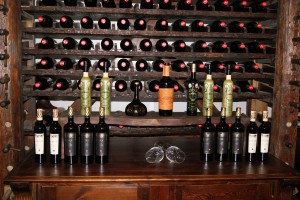DARK WINE FROM THE DARK HORSE
OF THE RECENT ALICANTE GOURMET FAIR ‘LO MEJOR DE LA GASTRONOMIA’
If it wasn’t for my contacts I might have missed the excellent Gourmet Fair in Alicante’s IFA Exhibition Centre. It’s clear that organisers, www.lomejordelagastronomia.com, need to be aware of the huge potential of sales to the English speaking extranjeros in the Alicante Province. I was unaware of any advertising in the English language media (and no press releases to me), which I’m sure accounted for the fact that I only heard two English voices during the whole six hours I was at this Mecca of Gastronomes!
The place was really heaving but there was room for more and I’m sure that readers would have loved it! The fair managed to strike the perfect balance between keeping professionals and consumers entertained, informed and happy – there were live TV cooking demonstrations, chef clothing and the latest ovens for sale as well as very well priced tapas and wine combinations. An outstanding success!
Of course I was there for the wine! Food related stands considerably outnumbered wine stands but there was nevertheless plenty of wine to see and taste. And for me one of the stars of the show came from a small, almost anonymous stand under the generic banner of the DO Alicante. Bodegas Sierra de Cabreras is nestled into the hills of the mountain range Sierra Salinas on the DO border between Yecla and Alicante, and making top class red wine!

Any wine sold in El Corte Inglés Gourmet section has to be worthy of note and at 19€ per bottle, although relatively expensive, it’s very good value for money. Were this same wine made elsewhere in a more famous area I’m sure it would command a price into the top twenties, at least!
They make just one wine (watch this space though, as their fame grows I’m sure their portfolio will too), Carabibas and it’s super! Almost opaque, this very dark red wine is made from 60 years old Monastrell vines with the addition of some Cabernet and Merlot.
The 2010 is fruit driven, but it’s complex too with racy acidity and maturing tannin and is a classic wine in waiting, though drinking very well now. The owners told me that it had only just been bottled following nine months ageing in French oak. I intend to lay down some bottles of this to see how it matures over four or five years.
The 2009 is a different wine and yet made with the same varieties in roughly the same proportions. It’s more subtle on the nose, though its lovely damson fruit is nevertheless to the fore. The gentle, sensitive oak ageing has added an extra dimension over time, and will do so still as the wine evolves over the next, perhaps eight years. I enjoyed this dark horse wine as much as the next!
Muga’s Prado Enea Gran Reserva 2004 is of course from an excellent year and whilst not just tasting the wine but drinking it too I was struck once again by the superb quality that is available in Spain, and in this case in the most famous of Spanish producing areas, La Rioja. I’ve written about this wine and Bodegas Muga several times before so I won’t say anything more, except to repeat the advice that, here you can buy Rioja with total confidence, which cannot be said about all bodegas from this area! They even manage to make a characterful white wine, using Viura – which for me speaks volumes!
Another highlight of the fair was the wine portfolio of Bodegas Francisco Gomez whose organic (all their wines are organic) Sauvignon Blanc was full of fresh

varietal character. Their red Fruto Noble 2006 Crianza made with Cabernet, Monastrell and Syrah is well endowed with ripe fruit plus the backing of 12 months in oak.
Serrata 2006 Reserva is made with Merlot, Petit Verdot, Cabernet and Monastrell and initially reminds me of some of the full flavoured Chilean wine I sampled when last in UK, but with a good length. The fruit hits, slightly disappears on the mid-palate but returns on the finish – I wonder if it might have been a slightly better wine with a few months less oak?
So, if I can persuade the organisers of this fine food and wine fair to give me some advance notice next year I’ll post it here so you can enjoy it for yourself. PS I’ll be discussing some alternative Christmas Day wines on Bay Radio Sunday 18th December, 12:00 – 13:00 hrs – why not tune in or listen on-line (www.bayradio.fm)?
